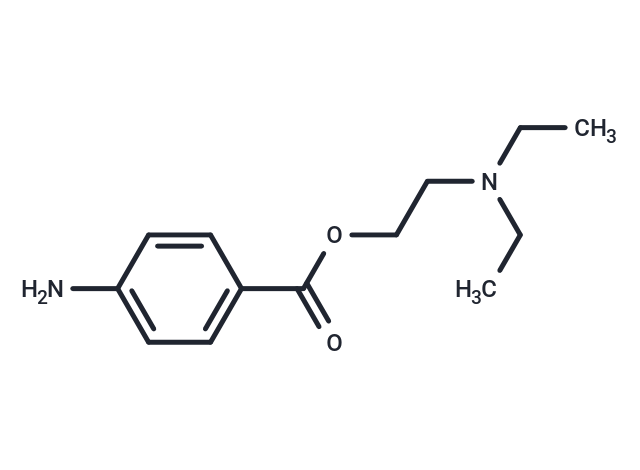Shopping Cart
- Remove All
 Your shopping cart is currently empty
Your shopping cart is currently empty
Procaine (Vitamin H3) is a local anesthetic of the ester type that has a slow onset and a short duration of action. It is mainly used for infiltration anesthesia, peripheral nerve block, and spinal block.

| Pack Size | Price | Availability | Quantity |
|---|---|---|---|
| 500 mg | $33 | In Stock | |
| 1 g | $42 | In Stock | |
| 5 g | $68 | In Stock | |
| 10 g | $98 | In Stock | |
| 25 g | $163 | In Stock |
| Description | Procaine (Vitamin H3) is a local anesthetic of the ester type that has a slow onset and a short duration of action. It is mainly used for infiltration anesthesia, peripheral nerve block, and spinal block. |
| In vitro | The viability of HLE, HuH7, and HuH6 cells is significantly decreased by procaine treatment. Inhibition of S/G2/M transition, morphological changes such as vacuolation and no increase in apoptosis rate are observed in the procaine-treated HLE cells. All the genes transcriptionally suppressed by DNA hypermethylation are demethylated and reactivated with procaine treatment. Procaine has growth-inhibitory and demethylating effects on human hepatoma cells[2]. |
| In vivo | Procaine has a growth-inhibitory and demethylating effect against xenograft in vivo[2]. |
| Kinase Assay | Biochemical Assays: Compound potency is also assessed through incorporation of 3H-SAM into a biotinylated H3 peptide. Specifically, PRC2 containing either EZH1 (160 pM), wt EZH2 (40 pM), or Y641N mutant EZH2 (80 pM, both EZH2 prepared in-house) is pre-incubated with 3H-SAM (0.9 μM), 2 μM H3K27me3 activating peptide (H2N-RKQLATKAAR(Kme3)SAPATGGVKKP-amide) and compounds (as 10 point duplicate dose response titrations) for 120 min in a buffer consisting of 50 mM Tris (pH 8.5), 1 mM DTT, 0.07 mM Brij-35, 0.1% BSA, and 0.8% DMSO in a total volume of 12.5 μl in a black 384 well plate. Reaction is initiated with biotinylated H3 substrate peptides (H3K27me1 for wt EZH2, H3K27me2 for Y641N mutant EZH2; H2N-RKQLATKAAR(Kmen)SAPATGGVKKP-NTPEGBiot) as a 2 μM stock in 12.5 μL and allowed to react at room temperature for 5 h. Quenching is accomplished by addition of 20 μl of STOP solution (50 mM Tris (pH 8.5), 200 mM EDTA, 2 mM SAH). 35 μL of the quenched solution is transferred to Streptavidin Flashplates, incubated overnight, washed, and read in a TopCount Reader. For titrations all compound dilutions are in DMSO, final DMSO concentrations are 0.8% (v/v), and turnover is kept to less than < 5%. IC50s are calculated using non-linear least square four parameter fits (GraphPad 6.0). |
| Cell Research | For apoptosis analysis, the TUNEL assay is performed on HLE cells treated with no drug(control), or 1 μM of DAC(5-aza-2'-deoxycytidine), or 1 mM of PCA(procaine), or 1 mM of PCAA(procainamide) for 96 h. The proportion of TUNEL-positive cells was calculated by counting at least 500 cells randomly. All assays were carried out in triplicate. (Only for Reference) |
| Synonyms | Vitamin H3, Spinocaine, Novocaine, Duracaine |
| Molecular Weight | 236.31 |
| Formula | C13H20N2O2 |
| Cas No. | 59-46-1 |
| Smiles | CCN(CCOC(C1=CC=C(C=C1)N)=O)CC |
| Relative Density. | 1.077g/cm3 |
| Storage | store at low temperature | Powder: -20°C for 3 years | In solvent: -80°C for 1 year | Shipping with blue ice/Shipping at ambient temperature. | |||||||||||||||||||||||||||||||||||
| Solubility Information | H2O: < 1 mg/mL (insoluble or slightly soluble) DMSO: 47 mg/mL (198.89 mM), Sonication is recommended. Ethanol: 43 mg/mL (181.96 mM), Sonication is recommended. | |||||||||||||||||||||||||||||||||||
Solution Preparation Table | ||||||||||||||||||||||||||||||||||||
Ethanol/DMSO
| ||||||||||||||||||||||||||||||||||||

Copyright © 2015-2025 TargetMol Chemicals Inc. All Rights Reserved.